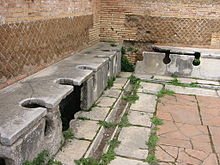Xylospongium
The xylospongium is an ancient device that is considered the forerunner of the modern toilet brush. It consists of a wooden stick ( Greek ξύλον xylon 'wood'), at the end of which a sponge (Greek σπόγγος spongos 'sponge') is attached.
The expression on a fresco in the Baths of the Seven Wise Men in Ostia has been preserved in writing . Here, as early as the 2nd century, ancient visitors were encouraged to use the toilet brush with the reference (u) taris xylosphongio .
In the written tradition, the xylospongium is mentioned for the first time in a letter from Claudius Terentianus to his father Claudius Tiberianus , which has come down to us in a papyrus from the first quarter of the 2nd century. In it, C. Terentianus reproduces a proverbial use of the term.
The Roman philosopher Seneca reports in the middle of the first century of a Germanic gladiator who committed suicide in the lavatory of an amphitheater by driving a stick of a sponge stick into his throat.
At the end of the first century, Martial describes in one of his epigrams a "wretched sponge on a dishonorable stick" with which the remains of a meal are removed.
All primary sources imply an environmental context that suggests the use of xylospongium in ancient latrines, without explaining the exact handling.
In the older secondary literature there is often an interpretation of the use of xylospongium to clean the buttocks. In the 2003 edition of the Martial Edition from Lindsay and Patricia Watson, for example, it is explained that this device was used, "to wipe oneself after defecation", and then in the gutter that was in most public toilets for the next user cleaned. Sigwart Peters also assumed this use of the xylospongium in 2011. In an article in the Stuttgarter Zeitung on the history of the toilet, Robin Szuttor described in detail in 2011 that the xylospongium was passed between the legs to clean the anus and then squeezed out in a water-filled bucket.
However, according to Gilbert Wiplinger, this thesis on the use of xylospongium is not based on reliable sources and can be regarded as sufficiently refuted. At the Frontinus symposium Sanitas per aquam in 2009, Wiplinger proposed a new theory on the use of xylospongium, which he also published in 2012. He favors the use of xylospongium for the secondary cleaning of ancient toilets in a similar form to which modern toilet brooms are used today. In 2010, as part of the Nox Latina Viennensis, the question was raised whether the Romans were “wipers” or “washers”.
The discovery of numerous scraps of cloth in an ancient septic tank in Herculaneum led the environmental archaeologist Mark Robinson to conclude that these scraps were used for wiping up instead of the toilet paper commonly used today.
Primary sources
- Claudius Terentianus, Michigan Papyri VIII, 29–30 digitized
- Seneca, Epistulae morales 8, 70, 20
- Martial, Epigrammata 12, 48, 7
Secondary literature
- Richard Neudecker : The splendor of the latrine. On the change in public lavatories in the imperial city . Pfeil-Verlag, Munich 1994 (Studies on the Ancient City, Vol. 1) ISBN 3-923871-86-4 , pp. 36–37.
- Gilbert Wiplinger: The use of the xylospongium - a new theory on the hygienic conditions in Roman latrines. In: SPA. SANITAS PER AQUAM. Proceedings of the International Frontinus Symposium on the Technical and Cultural History of the Ancient Thermal Baths Aachen, 18. – 22. March 2009. Peeters, Leiden 2012, ISBN 978-90-429-2661-5 . Pp. 295-304
Remarks
- ↑ AE 1941, 5
- ↑ According to Mols , the word is written there without ph.
- ↑ Neudecker 1994, p. 36
- ↑ (29) ... Non magis quravit me pro xylesphongium (30) sed su (u) m negotium et circa res suas. - Translation: (29) ... He cared no more about me than for a xylospongium, (30) but about his and his things ... (Michigan Papyri VIII, 29-30)
- ↑ Seneca, Epistulae morales 8, 70, 20. Seneca describes the device as ... lignum id, quod ad emundanda obscena adhaerente spongia positum est ... - translation: ... such a wooden stick with a sponge on it to clean away the faeces ...
- ↑ Martial 12, 48, 7.
- ^ Martial, Select Epigrams. Edited by Lindsay and Patricia Watson, Cambridge University Press 2003, ISBN 978-0-521-55539-5 , p. 216.
- ↑ Sigwart Peters: Hygiene aspects in the valetudinarium on the Roman Rhine front . In: Dominik Groß et al. (Ed.): Medical history in spotlights. Contributions of the "Rheinischer Kreis der Medizinhistoriker" . Kassel 2011, ISBN 978-3-86219-000-3 , pp. 15th ff ., here p. 25 (382 p., uni-kassel.de [PDF; 4.0 MB ; accessed on June 25, 2017]).
- ↑ Robin Szuttor, history of the toilet. Water phobia in the Baroque and Rococo , in: Stuttgarter Zeitung, October 22, 2011
- ↑ Wiplinger 2012, pp. 298–299.
- ↑ Wiplinger 2012, pp. 300–301.
- ↑ Regina Loidolt, Nox Latina Viennensis MMX , in: Circulare 2, 2010, p. 8 (PDF; 5.2 MB)
- ↑ Jens Nicolai: ARCHEOLOGY : Findings from the cloaca . In: Der Spiegel . No. 45 , 2007 ( online ).

